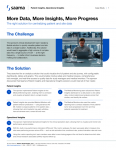Data warehouse identified as key to future drug R&D
directly to the general challenges facing drug development today as
development costs for new products have rocketed from $100m (€79m)
to $800m.
The considerable cost of collecting, analysing and reporting clinical trials to support the submission of a new drug product are well known and it is likely future submissions will go up against more stringent standards.
Speaking at the recent Pabord conference in London, Dr Nicholas Lakin, manager of Accenture's Health and Life Sciences practice in the UK, spoke about the need for players in the Pharmaceutical sector to maximise the return on their investment.
According to Lakin drug companies are currently following one of two paths to increase the value of their data.
By solving operative issues in conducting, analysing and reporting trials, companies can increase efficiency in obtaining their data faster, saving valuable time and cutting costs.
"Pharma must be aware that improving trial planning and design as well as enabling adaptive trial designs through fast availability of data are key to gaining maximum quality of generated data," said Lakin.
The other method seeks to find new ways to reuse data to obtain more knowledge. This can be achieved by using sophisticated exploration of legacy data to search for new indications or new targets subject groups.
Lakin commented:"In this way companies can apply this knowledge to design better trials, which can also enable patient risk profiling."
According to PhRMA's annual survey 2001, clinical evaluation in Phase I, II and III received 29.1 per cent of US R&D allocation in 1999. Clinical evaluation in Phase IV, by contrast, received 11.7 per cent.
The prospect of going over and revising mountains of data is vastly time-consuming with no guarantees of a successful end result. But Lakin argued that significant revenues might well be obtained by discovering alternative indications for compounds.
He pointed to Evista (Raloxifene), which was originally indicated for the treatment of osteoporosis but was found to have efficacy for breast cancer. Evista, which has been approved for osteoporosis, has been shown in studies to help prevent the occurence of breast cancer in high-risk women.
Likewise, Viagra (Sildenafil) was the result of studies for a hypertension treatment but revisions on the generated data discovered it was better suited as an erectile dysfunction drug.
Wellbutrin (Bupropion) was also a drug originally indicated to treat depression but was marketed as a treatment for smoking cessation.
"By focusing on the exploration of existing data on such synergies, this will make it possible to reuse significant investments in pre-clinical and clinical testing, reducing the cost and effort of bringing the indication to market."
"Additionally, this will reduce the risk of project failure as these compounds are often well advanced in the R&D process, or even on the market," he added.
Lakin pointed to the development of a clinical data warehouse based on a standard data model as the ideal solution to offer both of these benefits.
He argued that productivity of statistical programs can be increased by the elimination of manual data cleansing operations. Moreover, time spent on data manipulation and joining for cross-trial analyses can also be reduced using a standardised data model and programs.
Additionally, exploration of a warehouse offers the possibility to identify new potential indications for existing products. It also should aid in the standardisation of study protocol and provide the opportunity for building better study designs based on knowledge of historical data.














